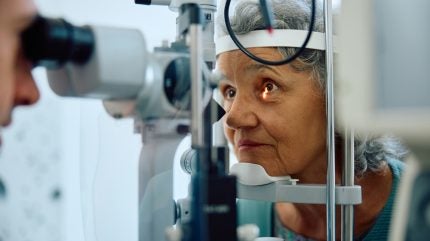
On October 18, at the 128th Annual Meeting of the American Academy of Ophthalmology (AAO) 2024 in Chicago, IL, US, clinical trial results were presented for the Phase II trial of EyePoint’s EYP-1901 (vorolanib) (DAVIO 2; NCT05381948), investigating its application in the treatment of wet age-related macular degeneration (wAMD). To date, this is the largest intravitreal tyrosine kinase inhibitor trial. Currently, the wAMD space is saturated with many anti-vascular endothelial growth factor (VEGF) therapies. Therefore, it is of paramount interest that therapies with other mechanisms of action enter the wAMD market to broaden the range of therapeutic approaches available for this indication.
EYP-1901 comprises vorolanib, a powerful receptor tyrosine kinase inhibitor (TKI) that selectively inhibits VEGF receptors 1, 2, and 3. It is delivered via an intravitreal insert, Bioerodible Durasert E, facilitating sustained drug delivery for over six months. In addition to EYP-1901’s ability to be delivered with zero-order kinetics for continuous dosing, other benefits of EYP-1901 include its ability to achieve therapeutic concentrations in target tissues within hours of administration, to be emptied before bioerosion of the matrix occurs, and to be kept at room temperature.
The objective of this Phase II study was to evaluate 12-month data on EYP-1901’s efficacy and safety in patients with wAMD. Criteria for inclusion comprised a wAMD diagnosis, best corrected visual acuity (BCVA) between 85 to 35 letters (20/20 to 20/200), prior response to anti-VEGF treatment, and receipt of two or more anti-VEGF therapies within the past six months. The study comprised 161 patients split between three arms: EYP-1901 2mg (low dose; n=53); EYP-1901 3mg (high dose, n=54); and the standard of care, which was aflibercept 2mg every eight weeks (n=54). Patients in both EYP-1901 arms received a single injection of EYP-1901 at week 8 of the study.
In results reported on October 18 by Dr Carl D. Regillo, MD, FACS, FASRS, Director of the Retina Service of Wills Eye Hospital and Professor of Ophthalmology at Thomas Jefferson University School of Medicine, EYP-1901 demonstrated comparable efficacy to aflibercept dosed every eight weeks. At months 7 and 8, the blended average BCVA change from baseline, measured in Early Treatment Diabetic Retinopathy Study (ETDRS) letters, was +1.0 for the EYP-1901 2mg group, +0.9 for the EYP-1901 3mg group, and +1.3 for the Aflibercept every eight weeks group, thus meeting the study’s primary endpoint. For optical coherence tomography (OCT) results, at month 8, the central subfield thickness (CST) change from baseline was an average of +17.8µm for EYP-1901 2mg, +10.6µm for EYP-1901 3mg, and +5.4µm for aflibercept every eight weeks. By month 12, CST changes were +21.2µm for EYP-1901 2mg, +11.1µm for EYP-1901 3mg, and +11.2µm for aflibercept every eight weeks. The study also investigated the need for supplemental injections across all three trial arms. By month 8, 63% of
patient eyes within the EYP-1901 2mg and 3mg groups were free of supplemental injections, compared to 87% in the aflibercept every eight weeks group. By month 12, 47% of patient eyes within the EYP-1901 2mg group, 52% of the EYP-1901 3mg group, and 68% of the aflibercept every eight weeks group remained supplemental injection-free. By month 14, these figures were 43% for the EYP-1901 2mg group, 46% for the EYP-1901 3mg group, and 65% for the aflibercept every eight weeks group.
Treatment burden was also studied in DAVIO 2, revealing that after the loading phase, the mean number of injections over 12 months was considerably lower for the EYP-1901 groups. Patients receiving aflibercept every eight weeks averaged 6.1 injections, compared to EYP-1901, where treatment burden that was 70% lower, with an average of 1.8 injections over 12 months. For EYP-1901 3mg, the burden was 69% lower than that of aflibercept every eight weeks, averaging 1.9 injections. DAVIO 2 also examined the relationship between treatment burden compared to the 12 months preceding the trial and found that in the EYP-1901 2mg group, 43% of patients were injection-free up to month 14, reflecting an 81% reduction compared to pre-trial treatment. In the EYP-1901 3mg group, 46% of patients were injection-free at month 14, denoting an 80% reduction versus pre-trial treatment.
Regarding safety, there were no ocular or systemic severe adverse events (SAEs) associated with EYP-1901. While adverse events (AEs) were reported for 97% of trial participants, such cases were predominantly mild to moderate, and somewhat anticipated due to the route of administration employed. Nonetheless, there were no treatment-related discontinuations, incidences of retinal occlusive vasculitis were not observed, and there were no instances in which the insert migrated into the interior chamber.
Key opinion leaders (KOLs) interviewed by GlobalData have emphasized their excitement over EYP-1901, with one KOL stating that “although it’s…in clinical development, I think this drug could potentially do very, very well…I think this can achieve durability that some of the other drugs that are currently approved on the market have not yet been able to achieve.”
Results presented from the DAVIO 2 study demonstrated non-inferiority to aflibercept every eight weeks, signified by EYP-1901’s potential to provide treatment without the need of supplemental injections in 63% of patients at six months, and 44% at 12 months following administration, while simultaneously maintaining BCVA. This emphasizes its ability to alleviate the treatment burden faced by patients with wAMD. Over the 12-month trial duration, EYP-1901 achieved over 80% treatment burden reduction compared to pre-trial levels, and established a good safety profile. If EyePoint further promotes the efficacy and safety of EYP-1901 through its prospective pivotal Phase III trials, LUGANO and LUCIA, which are scheduled to initiate later in the year, this therapy may be set on a trajectory to compete with anti-VEGF therapies in the wAMD space.
According to GlobalData’s Pharma Intelligence Center, there are currently 30 Phase III candidates, 36 Phase II candidates, and 15 Phase I candidates for wAMD globally.



